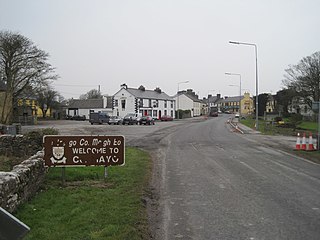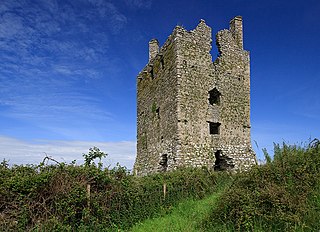
Earl of Clanricarde is a title that has been created twice in the Peerage of Ireland, first in 1543 and again in 1800. The former creation became extinct in 1916 while the 1800 creation is extant and held by the Marquess of Sligo since 1916.
William Óge Martyn was the 101st Mayor of Galway.

The House of Burgh or Burke was an ancient Anglo-Norman and later Hiberno-Norman aristocratic dynasty who held the earldoms of Kent, Ulster, Clanricarde, and Mayo at various times, provided one Queen Consort of Scotland, and played a prominent role in the Norman invasion of Ireland.

William de Burgh was the founder of the House of Burgh in Ireland and elder brother of Hubert de Burgh, 1st Earl of Kent and Geoffrey de Burgh, Bishop of Ely.
Sir William Óg de Burgh was an Anglo-Irish noble and soldier who was the ancestor of the Earls of Clanricarde and the Mac William Iochtar.

William de Burgh, 3rd Earl of Ulster and 4th Baron of Connaught was an Irish noble who was Lieutenant of Ireland (1331–2) and whose murder, aged 20, led to the Burke Civil War.
The Burke/de Burgh Civil War was a conflict in Ireland from 1333 to 1338 between three leading members of the de Burgh (Burke/Bourke) Anglo-Norman family resulting in the division into three clans.

Sir Uilleag (Ulick) de Burgh (Burke), 1st Clanricarde or Mac William Uachtar was an Irish chieftain and noble who was leader of one of the three factions who fought the Burke Civil War in the 1330s. By the end of the conflict he had established himself and his descendants as Clanricarde, also known as Mac William Uachtar, independent lords of Galway. He was succeeded by his son, Richard Óg Burke, 2nd Clanricarde (d.1387).

Clanricarde, also known as Mac William Uachtar or the Galway Burkes, were a fully Gaelicised branch of the Hiberno-Norman House of Burgh who were important landowners in Ireland from the 13th to the 20th centuries.

Shrule is a village on the N84 road in County Mayo in Ireland. The county boundary between Mayo and County Galway follows the course of the Black River on the south side of the village.

Sir Richard Bingham was an English soldier and naval commander. He served under Queen Elizabeth I during the Tudor conquest of Ireland and was appointed governor of Connacht.
Sir Edmund de Burgh was an Irish knight and ancestor of the Burke family of Clanwilliam.
Sir Edward Fitton the elder, was Lord President of Connaught and Thomond and the Vice-Treasurer of Ireland.

John "na Seamer" Burke, Baron Leitrim, also known as John of the Shamrocks, was one of the notorious half-brothers called the meic an Iarla, whose conflicts with each other and their father, Richard Burke, 2nd Earl of Clanricarde, caused devastation to south Connacht several times between the late 1560s and early 1580s.

Mac William Íochtar, also known as the Mayo Burkes, were a fully Gaelicised branch of the Hiberno-Norman House of Burgh in Ireland. Mayo covered much of the northern part of the province of Connacht and the Mac William Íochtar functioned as a regional king and received the White Rod. The title was a successor office to the Lord of Connacht which ended upon the assassination of William Donn de Burgh, 3rd Earl of Ulster, in June 1333.
Richard Óg de Burgh was an Anglo-Irish noble and soldier who was the ancestor of de Burgh/Burkes of Clanricarde.
Tibbot MacWalter Kittagh Bourke, 21st Mac William Íochtar was the first and last person to hold that title following its restoration. He was inaugurated at Kilmaine by Hugh Roe O'Donnell in December 1595 to secure Mayo for the rebel Irish Alliance during the Nine Years' War. His rule was opposed by many Bourke nobles, most notably by his arch-rival, the loyalist chief Tibbot na Long Bourke. The two men fought for supremacy over the MacWilliam Lordship throughout the war and control of the area changed hands on numerous occasions. Following Kittagh's flight to Spain in 1602, the MacWilliam chieftainship was abolished yet again, and Tibbot na Long would thereafter be made Viscount Mayo.

Richard Óg de Burgh, 2nd Earl of Ulster and 3rd Baron of Connaught, called The Red Earl, was one of the most powerful Irish nobles of the late 13th and early 14th centuries and father of Elizabeth, wife of King Robert the Bruce of Scotland.

Kinlough Castle is a tower house and National Monument located in County Mayo, Ireland.
The Battle of Thomond was fought in Ireland on 14 July 1328 between the forces of William de Burgh and an army led by Brian Bán Ó Briain, Lord of Thomond. It was fought near Thurles in modern County Tipperary and featured powerful Gaelic Irish and Hiberno-Norman figures on both sides.







